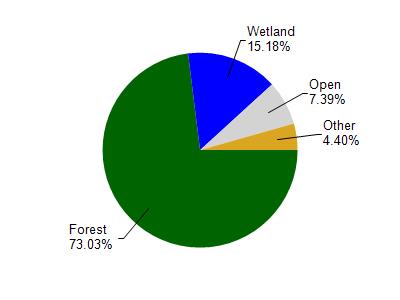Washburn
No
No
No
Fish and Aquatic Life
Overview
Pear Lake, in the Lower Namekagon River Watershed, is a 50.44 acre lake that falls in Washburn County. This lake is managed for fishing and swimming and is currently not considered impaired.
Date 2011
Author Aquatic Biologist
Historical Description
Source: 1978, Surface Water Resources of Washburn County Pear Lake, T41N, R13W, Section 9, 16, Surface Acres-49.1, Maximum Depth-32 feet, M.P.A.-41 ppm, Secchi Disk-12 feet A soft water, seepage lake in the northwest part of the county off State Highway "77". It is landlocked and pear-shaped. Its fishery is composed of walleyes, northern pike, largemouth bass, ,abundant slow-growing bluegills, black crappies, rock bass, pumpkinseeds, a few smallmouth bass, brown bullheads, white suckers, redhorse and common shiners. Most of the lakeshore is steep sloping except on the south end where a sedge meadow and a tamarack bog touch the lake. The area of these wetlands is 31 acres. Aquatic vegetation growth is sparse except on the shallow bar that is located in the middle of the lake. Vegetation species here are predominantly bulrushes and coontail. Most of the remaining lakeshore is wooded with mixed hardwoods and pine, other than the wetlands. The littoral bottom types are 67 percent sand, 32 percent gravel and one percent muck. The lake provides nesting for mallards and loon. Furbearer use on the lake is small. Private development includes a resort and boat rental and three cottages. Over half the lakeshore is in boy scout ownership. Public frontage includes the state-owned access site off the highway on the north end and three small, undeveloped platted access sites for a total of 0.03 mile of frontage.
Date 1978
Author Surface Water Inventory Of Wisconsin
Condition
Wisconsin has over 84,000 miles of streams, 15,000 lakes and milllions of acres of wetlands. Assessing the condition of this vast amount of water is challenging. The state's water monitoring program uses a media-based, cross-program approach to analyze water condition. An updated monitoring strategy (2015-2020) is now available. Compliance with Clean Water Act fishable, swimmable standards are located in the Executive Summary of Water Condition in 2018. See also the 'monitoring and projects' tab.
Reports
Management Goals
Wisconsin's Water Quality Standards provide qualitative and quantitative goals for waters that are protective of Fishable, Swimmable conditions [Learn more]. Waters that do not meet water quality standards are considered impaired and restoration actions are planned and carried out until the water is once again fishable and swimmable
Management goals can include creation or implementation of a Total Maximum Daily Load analysis, a Nine Key Element Plan, or other restoration work, education and outreach and more. If specific recommendations exist for this water, they will be displayed below online.
Monitoring
Monitoring the condition of a river, stream, or lake includes gathering physical, chemical, biological, and habitat data. Comprehensive studies often gather all these parameters in great detail, while lighter assessment events will involve sampling physical, chemical and biological data such as macroinvertebrates. Aquatic macroinvertebrates and fish communities integrate watershed or catchment condition, providing great insight into overall ecosystem health. Chemical and habitat parameters tell researchers more about human induced problems including contaminated runoff, point source dischargers, or habitat issues that foster or limit the potential of aquatic communities to thrive in a given area. Wisconsin's Water Monitoring Strategy was recenty updated.
Grants and Management Projects
Monitoring Projects
| WBIC | Official Waterbody Name | Station ID | Station Name | Earliest Fieldwork Date | Latest Fieldwork Date | View Station | View Data |
|---|
| 2488200 | Pear Lake | 10018244 | Pear Lake -- Access | 10/19/2006 | 5/31/2025 | Map | Data |
| 2488200 | Pear Lake | 10006950 | Pear Lake | 9/5/2000 | 9/12/2017 | Map | Data |
|

Watershed Characteristics
Pear Lake is located in the Lower Namekagon River watershed which is 239.34 mi². Land use in the watershed is primarily forest (73.10%), wetland (15.20%) and a mix of open (7.40%) and other uses (4.40%). This watershed has 172.53 stream miles, 12,590.30 lake acres and 21,781.64 wetland acres.
Nonpoint Source Characteristics
This watershed is ranked Not Ranked for runoff impacts on streams, Not Ranked for runoff impacts on lakes and Low for runoff impacts on groundwater and therefore has an overall rank of Low. This value can be used in ranking the watershed or individual waterbodies for grant funding under state and county programs.However, all waters are affected by diffuse pollutant sources regardless of initial water quality. Applications for specific runoff projects under state or county grant programs may be pursued. For more information, go to surface water program grants.